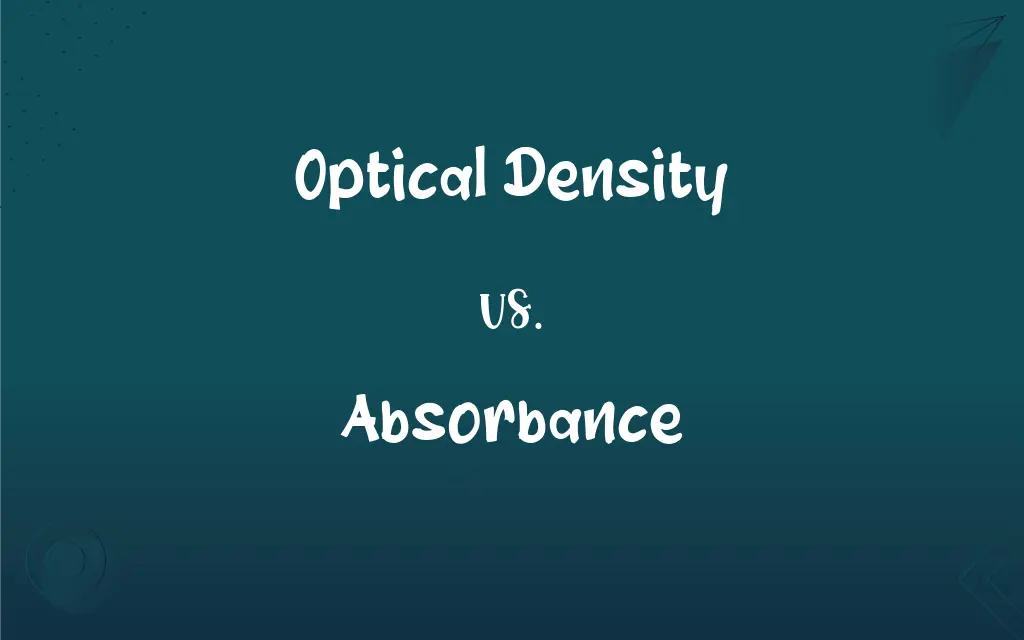Optical Density vs. Absorbance: What's the Difference?
Edited by Harlon Moss || By Janet White || Published on December 30, 2023
Optical density measures how much a substance hinders the passage of light, while absorbance quantifies the light absorbed by a substance.

Key Differences
Optical density refers to the degree to which a material impedes the transmission of light, considering factors like reflection and scattering. In contrast, absorbance specifically measures the amount of light absorbed by a material, without accounting for other light interactions.
Optical density is a broader concept encompassing the overall light attenuation properties of a substance, influenced by absorption, reflection, and scattering. Absorbance, however, isolates the light absorption aspect, ignoring how light might be reflected or scattered.
In measuring optical density, one assesses the total reduction in light intensity passing through a material. Absorbance measurement, on the other hand, is focused on the light absorbed by specific wavelengths, crucial in spectroscopy.
Optical density is often used in fields like microscopy and lens design, where light interaction with materials is complex. Absorbance is a key parameter in chemical analysis, such as spectrophotometry, to identify and quantify substances.
High optical density materials can be opaque or highly reflective, while high absorbance implies strong light absorption at certain wavelengths, often associated with specific chemical bonds or transitions.
ADVERTISEMENT
Comparison Chart
Nature of Measurement
Encompasses overall light attenuation
Measures light absorbed at specific wavelengths
Influencing Factors
Affected by absorption, reflection, and scattering
Influenced solely by absorption
Applications
Crucial in lens design and microscopy
Key in spectrophotometry and chemical analysis
Parameter Focus
Focuses on total light reduction
Focuses on specific light wavelengths absorbed
Optical Density and Absorbance Definitions
Optical Density
Optical density reflects the darkness or transparency of a material.
The optical density of photographic film is critical for image quality.
ADVERTISEMENT
Absorbance
Absorbance measures the amount of light a substance absorbs.
The absorbance of a solution helps determine its concentration.
Optical Density
Optical density indicates the absorbance capacity of a substance.
In microscopy, optical density is used to assess cell concentration.
Absorbance
Absorbance is the logarithmic ratio of transmitted to absorbed light.
In a spectrophotometer, absorbance is used to analyze chemical properties.
Optical Density
Optical density quantifies a material's capacity to attenuate light.
The optical density of the lens determines its effectiveness in blocking sunlight.
Absorbance
Absorbance is used to assess the concentration of solutes in a solution.
The absorbance of a dye in water indicates its purity.
Optical Density
Optical density measures the degree of light transmission hindrance.
Sunglasses with a higher optical density offer better UV protection.
Absorbance
Absorbance indicates the intensity of light absorption by a material.
The absorbance spectrum of a pigment determines its color properties.
Optical Density
Optical density is the logarithmic ratio of incident to transmitted light intensity.
A filter's optical density affects the brightness of the projected image.
Absorbance
Absorbance quantifies how much light is absorbed at specific wavelengths.
Different compounds have unique absorbance spectra for identification.
Absorbance
(physics) A logarithmic measure of the amount of light that is absorbed when passing through a substance; the capacity of a substance to absorb light of a given wavelength; optical density.
FAQs
What does optical density measure?
Optical density measures how much a substance hinders light transmission.
Is optical density affected by light scattering?
Yes, both light scattering and absorption influence optical density.
Can optical density indicate material opacity?
Yes, high optical density often correlates with material opacity.
Can optical density be negative?
No, optical density is always a non-negative value.
Does optical density have units?
Optical density is a dimensionless logarithmic scale.
Does absorbance measurement require a spectrophotometer?
Yes, spectrophotometers are commonly used for absorbance measurements.
Is absorbance affected by the color of a substance?
Yes, the color of a substance can influence its absorbance spectrum.
How does optical density relate to light intensity?
Optical density is a measure of the reduction in light intensity through a medium.
Can optical density be used in lens manufacturing?
Yes, optical density is important in designing lenses that filter light.
Can absorbance indicate chemical concentration?
Yes, absorbance is often used to calculate the concentration of chemicals.
Does optical density change with wavelength?
Optical density can vary across different wavelengths of light.
What is the primary use of absorbance?
Absorbance is primarily used to measure light absorbed by substances.
Is absorbance specific to certain wavelengths?
Yes, absorbance is measured at specific light wavelengths.
Is higher optical density always better?
The desirability of high optical density depends on the application.
Can optical density be used to measure fluid clarity?
Yes, it's used in assessing the clarity of fluids like water.
How is absorbance used in lab analysis?
Absorbance is used to identify and quantify substances in a lab.
Can absorbance help in identifying compounds?
Yes, different compounds have unique absorbance characteristics.
Is absorbance a direct measure of concentration?
Absorbance is indirectly related to concentration through Beer's Law.
Does the path length affect absorbance?
Yes, the path length of light through a medium affects absorbance.
Can absorbance be zero?
Yes, absorbance can be zero if no light is absorbed.
About Author
Written by
Janet WhiteJanet White has been an esteemed writer and blogger for Difference Wiki. Holding a Master's degree in Science and Medical Journalism from the prestigious Boston University, she has consistently demonstrated her expertise and passion for her field. When she's not immersed in her work, Janet relishes her time exercising, delving into a good book, and cherishing moments with friends and family.
Edited by
Harlon MossHarlon is a seasoned quality moderator and accomplished content writer for Difference Wiki. An alumnus of the prestigious University of California, he earned his degree in Computer Science. Leveraging his academic background, Harlon brings a meticulous and informed perspective to his work, ensuring content accuracy and excellence.







































































